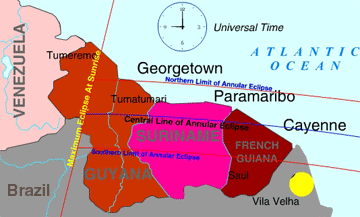 Autumn is almost here, and it's a wonderful time for stargazing. Find out what's up from Spaceweather PHONE.
Autumn is almost here, and it's a wonderful time for stargazing. Find out what's up from Spaceweather PHONE.
EQUAL NIGHT: On Saturday, Sept. 23rd (0403 UT), the sun crosses the celestial equator, marking the autumnal equinox--the first day of northern autumn. Equinox means equal night. With the sun on the celestial equator, Earthlings will experience 12 hours of daylight and 12 hours of darkness. It's also the beginning of aurora season!
SOLAR ECLIPSE: There's an annular solar eclipse tomorrow, Friday, Sept. 22nd. It begins at 0930 UT when the sun, not an orb but a ring, rises over Surinam and Guyana:

Image credit: Larry Koehn.
Annular eclipses occur when the Moon passes straight in front of the sun but fails to cover the entire solar disk. A sliver of sun pokes out in all directions producing a ring of fire.
Unfortunately, almost all of Friday's eclipse takes place over uninhabited ocean. The narrow red line in this map traces the "path of annularity." After leaving French Guiana, it touches nothing solid for thousands of miles. Only in the tiniest countries of South America will the ring of fire be visible from land.
Elsewhere, the sun will appear as a crescent, a result of the Moon crossing off-center. In Brazil and Argentina, people will experience a crescent sunrise. Later in the day, crescent sunbeams will dapple the ground in Africa. None of the eclipse will be visible from North America, Europe or Asia. More information:
Maps and Timetables | Safe Solar Filters
DAYLIGHT ISS: On Sept. 19th, the International Space Station passed over Wirral, England. John Locker photographed it in broad daylight:
|  computer model computer model |
At the time of the flyby, the station was a trifle brighter than a first-magnitude star--invisible to the naked eye at mid-day, but a relatively easy target for Locker's 8-inch telescope.
The blue-sky photo shows the station's new solar wings just installed by the crew of the space shuttle Atlantis. The new wings are vertical; the older ones are horizontal. They're all working together now to power the ISS.

